Ardour4 初学者教程 05 导出会话:修订间差异
小无编辑摘要 |
|||
| 第59行: | 第59行: | ||
=导出一个区域= | =导出一个区域= | ||
You may wish to Export only a Region of your Session, perhaps to use as a sample in another application, or to Edit it in a different editor program. This chapter shows you how. | |||
==导出一个区域== | |||
To Export a Region, select it (so it becomes blue), and then right-click into the sub-menu Export, or use the top menu: Region > Export. | |||
http://brunoruviaro.github.io/ardour4-tutorial/images/Ardour4_Export_Region_1.png | |||
This will open up the same Export dialog box explained in the Exporting a Session chapter. Choose your options, and click “Export”. Only the selected Region will be exported. | |||
Please note that when exporting a Region, not all parameters and edits are exported. Trimmed, split, stretched and reversed regions can be exported, but edits such as and Panning, and Automation are not exported. Also, the volume of the audio Track itself or the Master Bus will not affect the exported file. To export these edits, please see the chapters on Exporting a Range and Exporting a Session. | |||
==一次导出多个区域== | |||
If you are building a collection of samples to use later in another software, and your samples are basically trimmed and edited Regions, at the end of the process you will need to export all of them. If the number is large, exporting them manually can be tedious. Here’s one way of exporting several Regions at once. | |||
In Grab Mode (shortcut “G”), select all the Regions you want to Export. They do not need to be on the same Track. | |||
http://brunoruviaro.github.io/ardour4-tutorial/images/Ardour4_Export_Region_Multiple_1.png | |||
Go to menu Region > Ranges and choose Add Range Marker Per Region. | |||
http://brunoruviaro.github.io/ardour4-tutorial/images/Ardour4_Export_Region_Multiple_2.png | |||
Ardour has now just created Range Markers that fit exactly the beginning and ending of your selected Regions (see the green rectangles in the Range Markers ruler): | |||
http://brunoruviaro.github.io/ardour4-tutorial/images/Ardour4_Export_Region_Multiple_3.png | |||
Go to menu Session > Export and choose Export to Audio File(s) (shortcut “Alt” + “E”). | |||
In the Export dialog box, click on the “Time span” tab. You will see all the newly created Ranges listed there. There is also a default Range that stands for the entire Session. | |||
Under “Time Span”, click “Select All”, and de-select the very first Range (the “session” Range). The reason is because we want to export the shorter Ranges, not the whole Session. | |||
http://brunoruviaro.github.io/ardour4-tutorial/images/Ardour4_Export_Region_Multiple_4.png | |||
Go back to the main tab (“File format”). | |||
Click “Export”. | |||
You Regions have now been exported to single audio files. | |||
IMPORTANT: this method exports everything that falls under each defined time range. In other words, if you have other regions in other tracks sounding simultaneously with the region(s) you want to export, they will be mixed together. Another way of looking at it is this: the export operation will export everything that plays under the defined time ranges. If that is not what you want, you can use solo or mute buttons on select tracks to ensure you export only what you want. | |||
=导出一个范围= | =导出一个范围= | ||
2015年11月25日 (三) 11:30的版本
导出一个会话
Exporting is the process of saving a Region, Track, or entire Session to a file on your computer which you can listen to, burn as a CD-R, or convert to an MP3 to share on a website.
导出整个会话
Once you have finished your composition, the most common export operation is to export the entire Session to an audio file.
Bird’s Eye View of Entire Session
At this point it’s a good idea to Zoom Out and take a look at your whole session before exporting.
Select “All” from the menu “Number of visible tracks”:
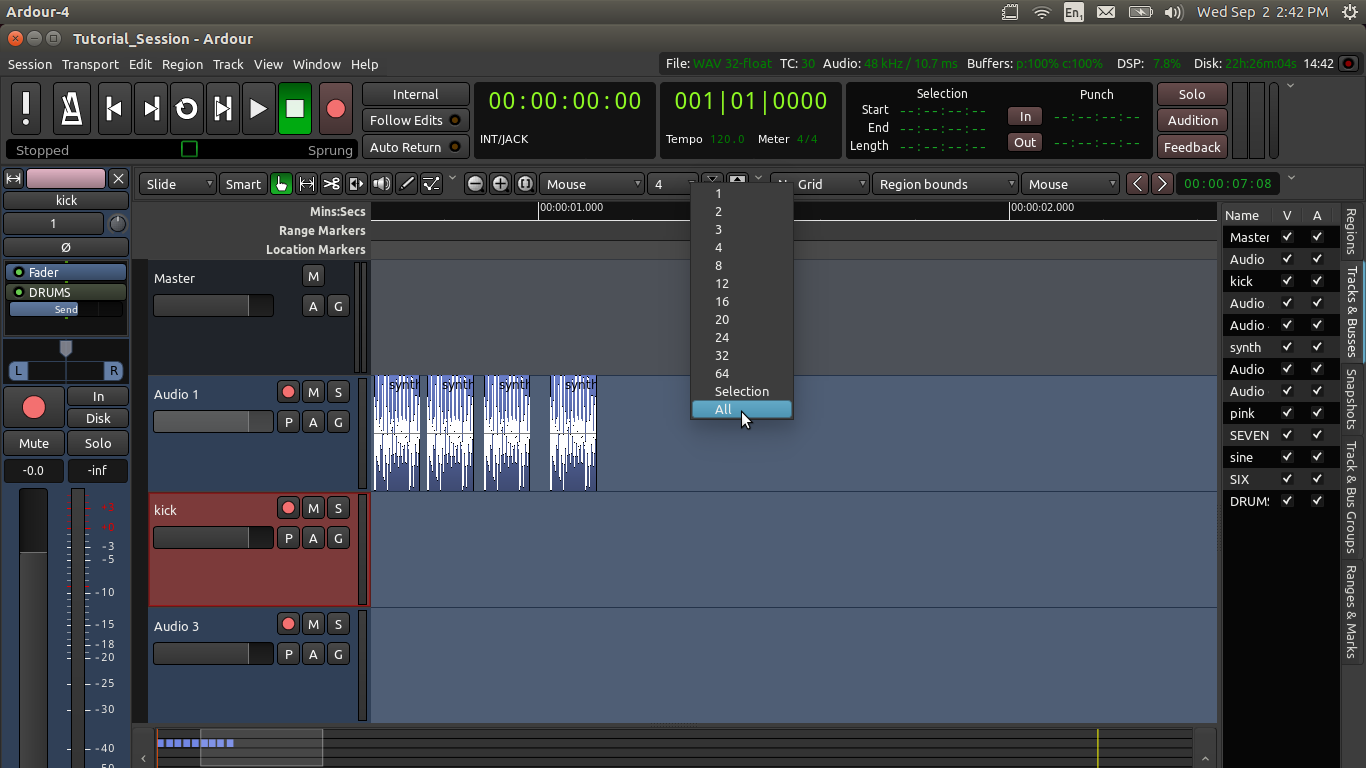
Click on the “Zoom to Session” button (third button in the Zoom Options):

You should now have a nice overview of your whole session, like this:
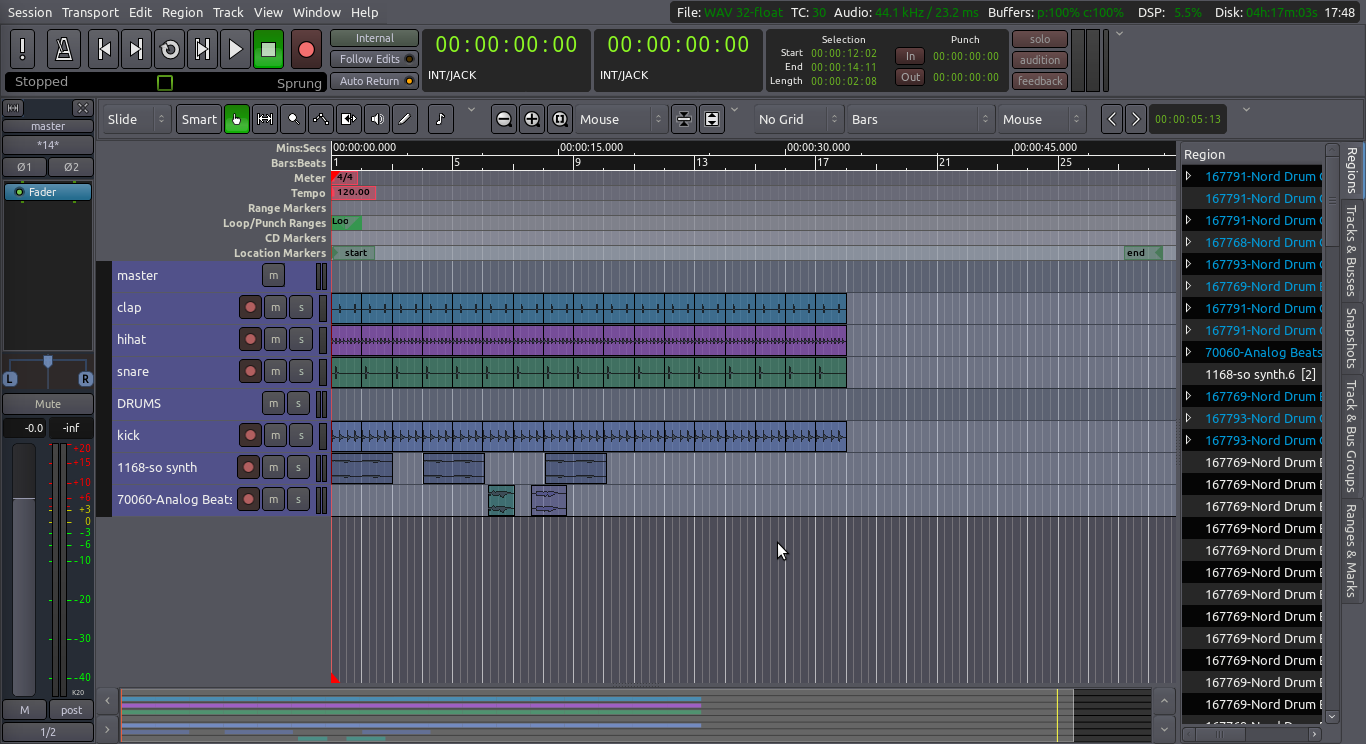
Listen to your piece one last time and make sure you hear everything the way you want (any Solo or Mute button you forgot to deactivate? Any volume adjusment left to do? etc.)
Start and End Markers
Finally, make sure the Start and End markers are in the right place.


Everything included between the Start and End Location Markers in the Timeline will be exported, so you have to set the markers first if they are not in the correct position. In the image below, clearly the End marker is too far to the right in the timeline. This will result in a huge silence after the end of the piece (that is, between the last Region and the End marker).
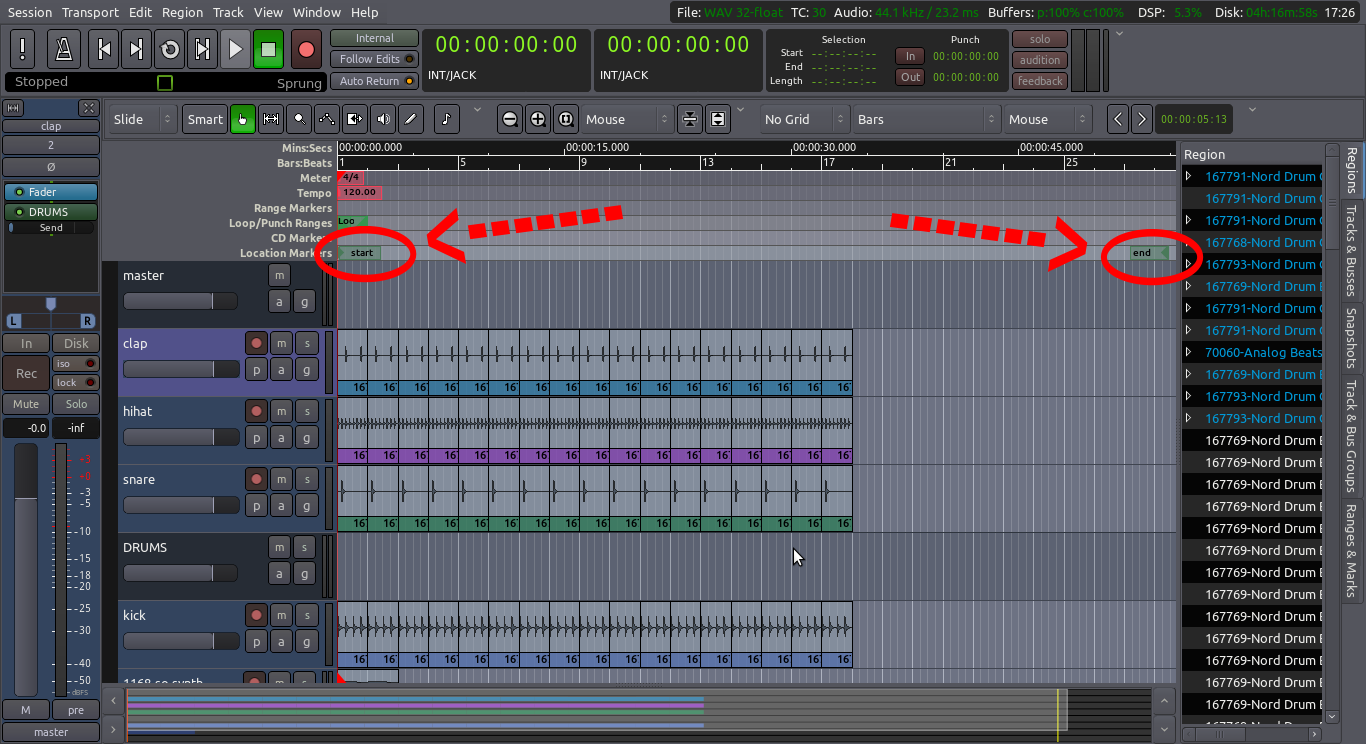
If your End marker is too far after the end of your piece, click and drag it to the left until it is pretty close to the end of the very last Region of your composition.
导出它!
To Export a Session, use the top menu: Session > Export > Export to Audio File(s)…. This will open up a dialogue box with several options.
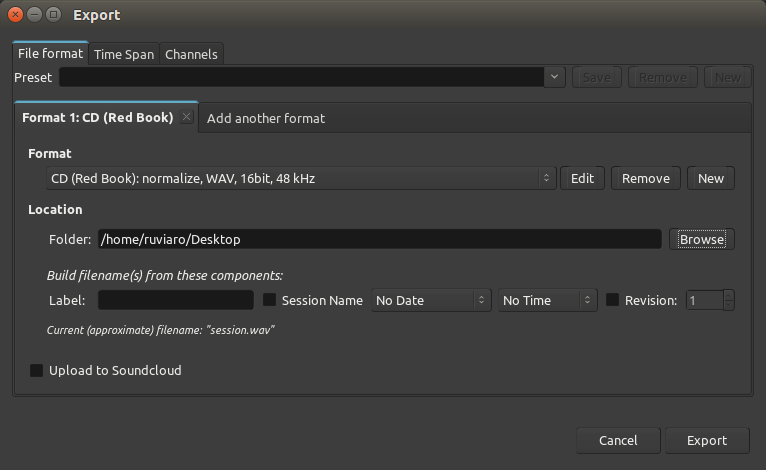
*Preset: this is NOT where you write the file name. Don’t worry about this field now. *Format: this allows you to choose the file format (WAV, MP3, OGG, FLAC, etc.). The default is CD (Red Book), which will give you a WAV file. *Add another format: if you’d like to export in more than one format at the same time, click on this tab. *Location: this is the place where you will find the file after it is saved. By default, it is in the “export” folder that lives inside your main Session folder. You could also click “Browse” and select the Desktop, for example. *Label: THIS is where you can create a unique name for the file. Ardour will automatically append the session name to the exported file, so if you don’t write anything here the name may end up something generic like “my-session.wav”. Use this field to give a unique name to your file.
Having chosen your options, click Export. After the operation is finished, you can find the file using your file browser.
TIP: Export is handled through the Master Bus, so the final file will include all the sounds from Tracks and Busses that were routed to it. This will include any Normalizing, Fading, Panning, and Automation you have created, along with the individual edits made to the Regions as well. If any of the Tracks have the Mute or Solo buttons engaged, this will also affect which Tracks will be heard in the Exported file.
高级选项
Click on the tabs “Time span” and “Channels” in case you need to access advanced export options.
导出一个区域
You may wish to Export only a Region of your Session, perhaps to use as a sample in another application, or to Edit it in a different editor program. This chapter shows you how.
导出一个区域
To Export a Region, select it (so it becomes blue), and then right-click into the sub-menu Export, or use the top menu: Region > Export.
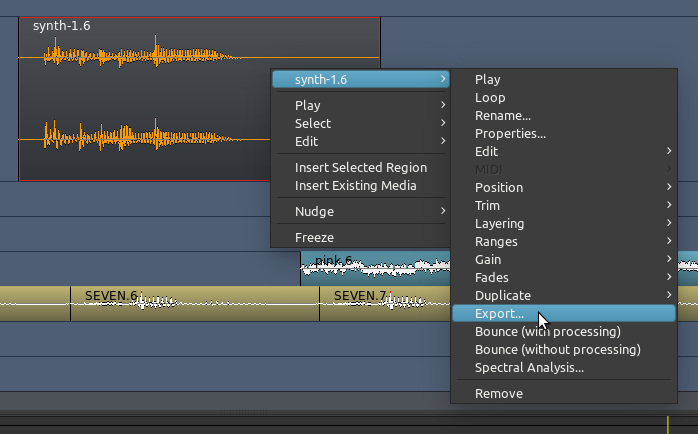
This will open up the same Export dialog box explained in the Exporting a Session chapter. Choose your options, and click “Export”. Only the selected Region will be exported.
Please note that when exporting a Region, not all parameters and edits are exported. Trimmed, split, stretched and reversed regions can be exported, but edits such as and Panning, and Automation are not exported. Also, the volume of the audio Track itself or the Master Bus will not affect the exported file. To export these edits, please see the chapters on Exporting a Range and Exporting a Session.
一次导出多个区域
If you are building a collection of samples to use later in another software, and your samples are basically trimmed and edited Regions, at the end of the process you will need to export all of them. If the number is large, exporting them manually can be tedious. Here’s one way of exporting several Regions at once.
In Grab Mode (shortcut “G”), select all the Regions you want to Export. They do not need to be on the same Track.
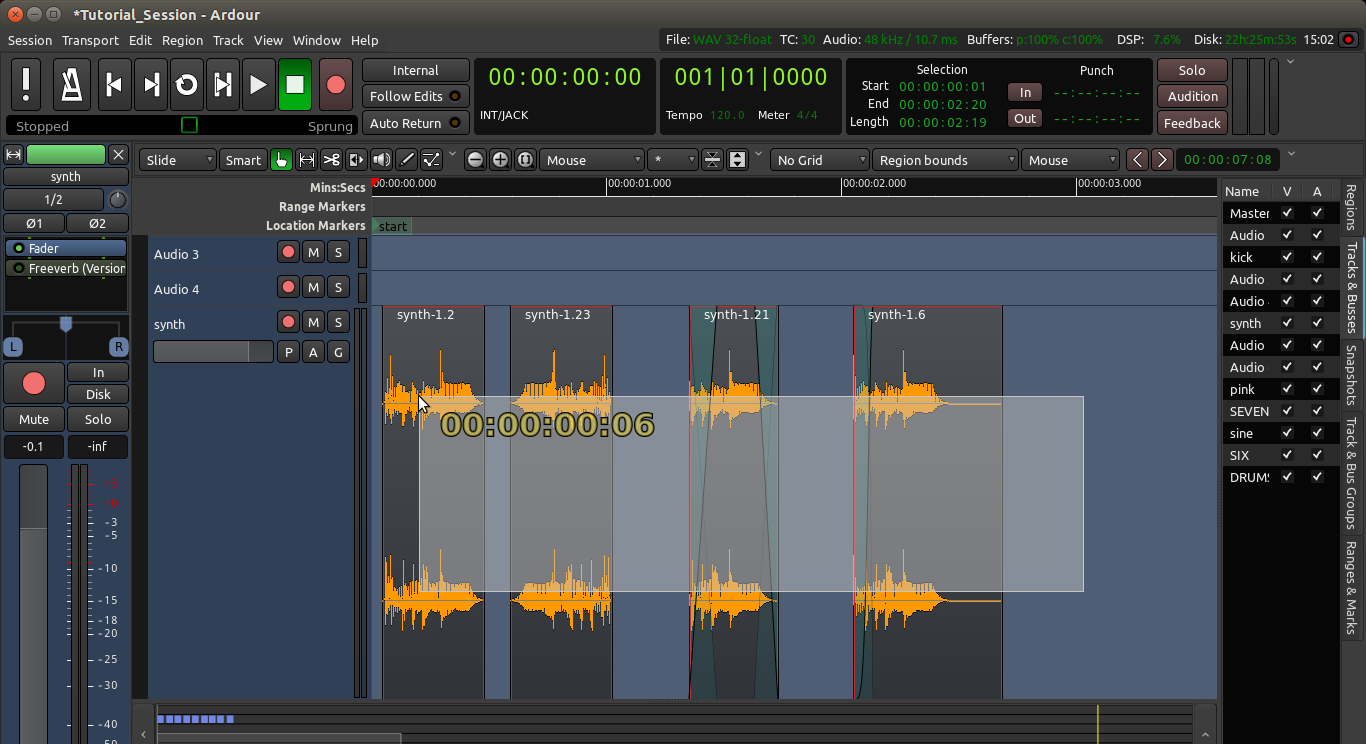
Go to menu Region > Ranges and choose Add Range Marker Per Region.
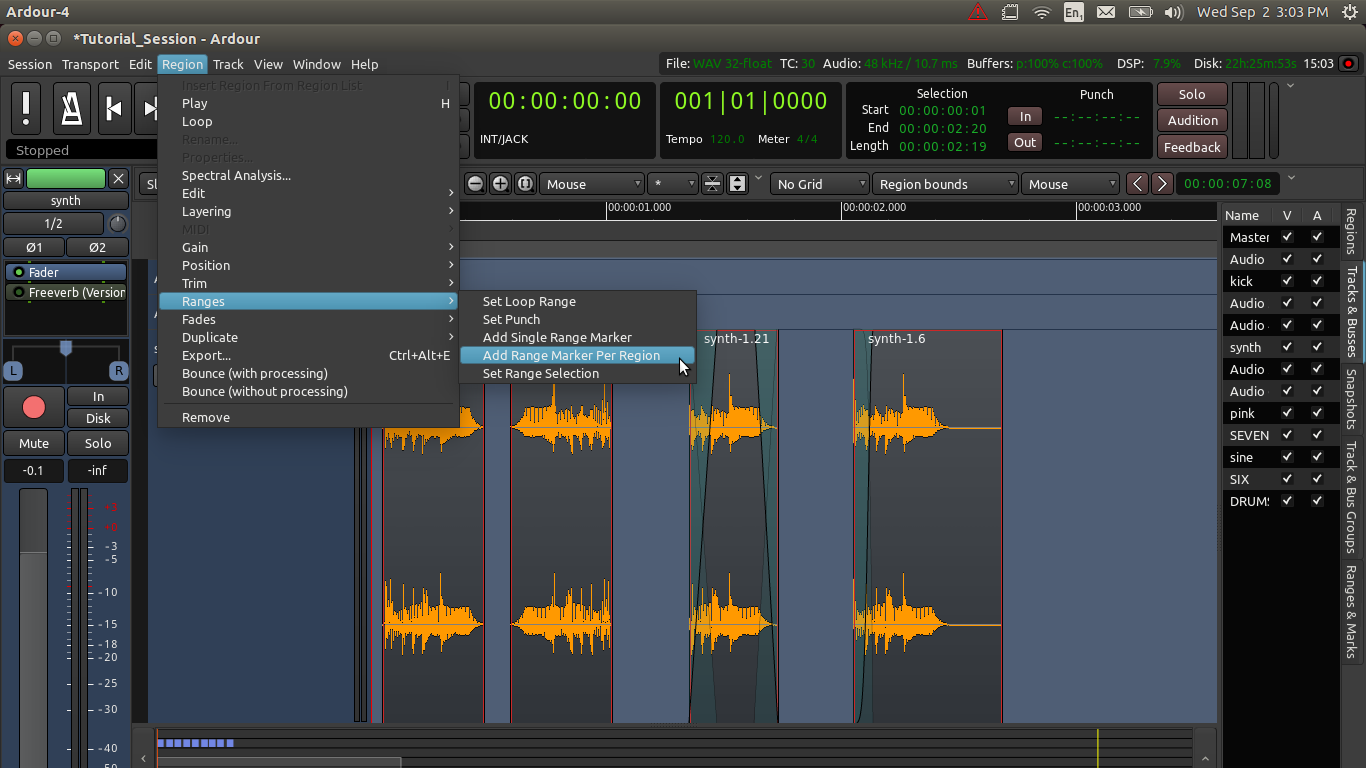
Ardour has now just created Range Markers that fit exactly the beginning and ending of your selected Regions (see the green rectangles in the Range Markers ruler):

Go to menu Session > Export and choose Export to Audio File(s) (shortcut “Alt” + “E”).
In the Export dialog box, click on the “Time span” tab. You will see all the newly created Ranges listed there. There is also a default Range that stands for the entire Session.
Under “Time Span”, click “Select All”, and de-select the very first Range (the “session” Range). The reason is because we want to export the shorter Ranges, not the whole Session.
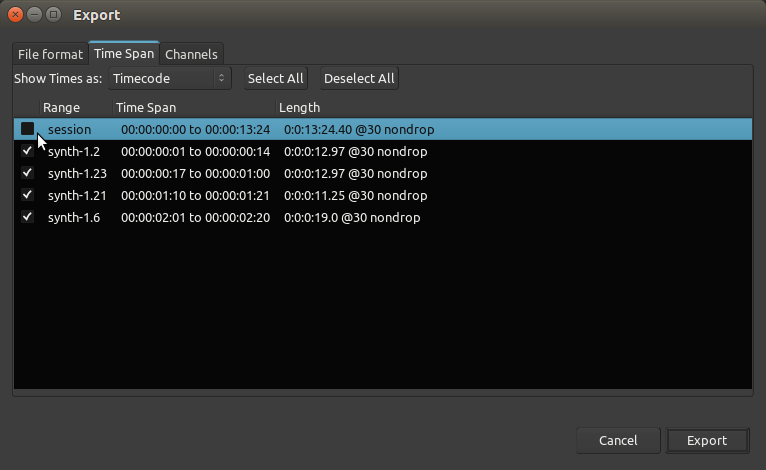
Go back to the main tab (“File format”).
Click “Export”.
You Regions have now been exported to single audio files.
IMPORTANT: this method exports everything that falls under each defined time range. In other words, if you have other regions in other tracks sounding simultaneously with the region(s) you want to export, they will be mixed together. Another way of looking at it is this: the export operation will export everything that plays under the defined time ranges. If that is not what you want, you can use solo or mute buttons on select tracks to ensure you export only what you want.